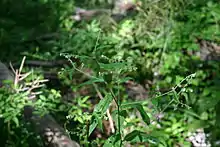Hackelia virginiana
Hackelia virginiana, a biennial plant, is commonly known as beggar's lice,[2][3] sticktight or stickseed.[3] However, the common names beggar's lice and stick-tight are also used for very different plants, such as Desmodium species that are also known as "tick-trefoil".[4][5]
| Hackelia virginiana | |
|---|---|
 | |
| Scientific classification | |
| Kingdom: | Plantae |
| Clade: | Tracheophytes |
| Clade: | Angiosperms |
| Clade: | Eudicots |
| Clade: | Asterids |
| Order: | Boraginales |
| Family: | Boraginaceae |
| Genus: | Hackelia |
| Species: | H. virginiana |
| Binomial name | |
| Hackelia virginiana | |
| Synonyms[1] | |
| |
Distribution
The plant is native to Eastern Canada and throughout the Midwestern and Eastern United States.
Description
Hackelia virginiana has simple, rough leaves and ribbed green stems. The plant is categorized Wetland Indicator Status: FACU (Facultative Upland).[6]
The flowers are small and white, bourne in mid-late summer.[7] The seeds are burs, and are very sticky. The plant is native but a well-known nuisance in deciduous forests of the eastern U.S. because the seeds can be difficult to remove from clothing and especially pet fur.[8] [9] The seeding part of the plant—the upper stem—dies earlier than most other plants, and becomes very brittle. Often the entire seed stem, or even the entire plant will come out of the ground if the seeds catch on clothing or fur, aiding seed dispersion.
During the plant's first year of growth it has only a basal rosette of foliage,[7] with the flowering stalk ascending the second year. The leaves are dark green and irregularly shaped.
References
- "The Plant List: A Working List of All Plant Species". Retrieved 17 July 2014.
- "PLANTS Profile for Hackelia virginiana | USDA PLANTS". Plants.usda.gov. Retrieved 2011-11-22.
- "Hackelia virginiana: UW-Stevens Point Freckmann Herbarium: Plant Details Page". Wisplants.uwsp.edu. Retrieved 2011-11-22.
- "Know Your Deer Plants: Beggar's Lice - Quality Deer Management Association". 25 January 2012.
- "MP903 Quail-Friendly Plants of the Midwest | Page 6 | University of Missouri Extension". extension.missouri.edu.
- "Virginia stickseed". minnesotaseasons.com. 21 Dec 2014. Retrieved 25 Jan 2015.
- "Stickseed (Hackelia virginiana)". Illinoiswildflowers.info. Retrieved 2011-11-22.
- "How to Remove Burrs and Stickers from a Dog's Fur | Pet Health Central".
- "Hackelia virginiana (Virginia Stickseed): Minnesota Wildflowers". www.minnesotawildflowers.info.
External links